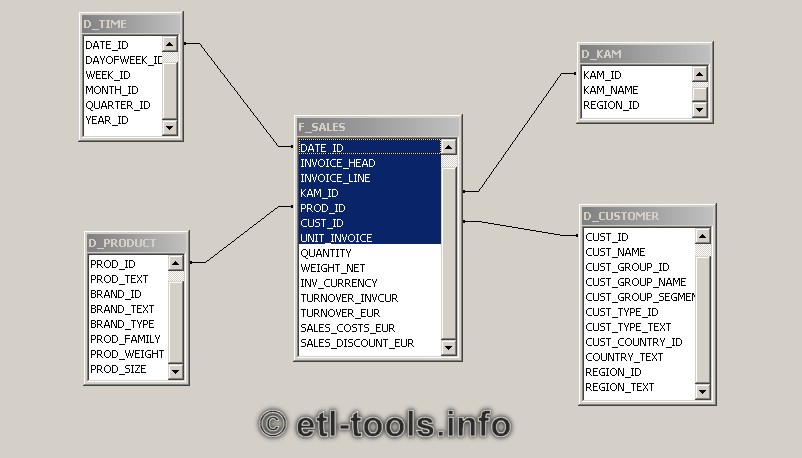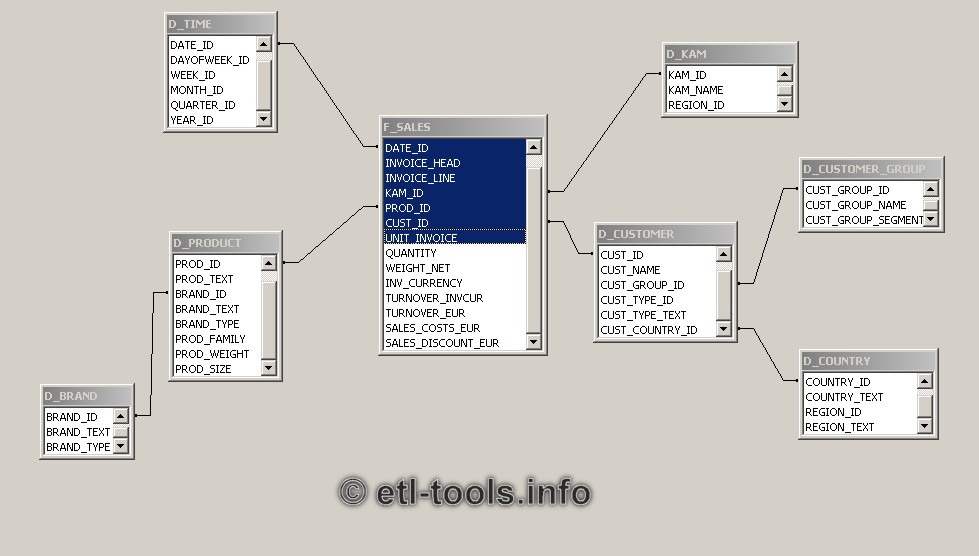Star Schema:
Star schema architecture is the simplest data warehouse design. The main feature of a star schema is a table at the center, called thefact table and the dimension tables which allow browsing of specific categories, summarizing, drill-downs and specifying criteria.
Typically, most of the fact tables in a star schema are in database third normal form, while dimensional tables are de-normalized (second normal form).
Despite the fact that the star schema is the simpliest datawarehouse architecture, it is most commonly used in the datawarehouse implementations across the world today (about 90-95% cases)

Snowflake Schema

More info:
Star schema architecture is the simplest data warehouse design. The main feature of a star schema is a table at the center, called thefact table and the dimension tables which allow browsing of specific categories, summarizing, drill-downs and specifying criteria.
Typically, most of the fact tables in a star schema are in database third normal form, while dimensional tables are de-normalized (second normal form).
Despite the fact that the star schema is the simpliest datawarehouse architecture, it is most commonly used in the datawarehouse implementations across the world today (about 90-95% cases)

Snowflake Schema
Snowflake schema architecture is a more complex variation of a star schema design. The main difference is that dimensional tables in a snowflake schema are normalized, so they have a typical relational database design.
Snowflake schemas are generally used when a dimensional table becomes very big and when a star schema can’t represent the complexity of a data structure. For example if a PRODUCT dimension table contains millions of rows, the use of snowflake schemas should significantly improve performance by moving out some data to other table (with BRANDS for instance).
The problem is that the more normalized the dimension table is, the more complicated SQL joins must be issued to query them. This is because in order for a query to be answered, many tables need to be joined and aggregates generated.
Snowflake schemas are generally used when a dimensional table becomes very big and when a star schema can’t represent the complexity of a data structure. For example if a PRODUCT dimension table contains millions of rows, the use of snowflake schemas should significantly improve performance by moving out some data to other table (with BRANDS for instance).
The problem is that the more normalized the dimension table is, the more complicated SQL joins must be issued to query them. This is because in order for a query to be answered, many tables need to be joined and aggregates generated.

What is a dimension table?
A dimensional table is a collection of hierarchies and categories along which the user can drill down and drill up. It contains only the textual attributes
What is Fact table?
Fact Table contains the measurements or metrics or facts of business process. If your business process is "Sales”, then a measurement of this business process such as "monthly sales number" is captured in the Fact table. Fact table also contains the foreign keys for the dimension tables.
More info:
Star schema architecture is the simplest data warehouse design. The main feature of a star schema is a table at the center, called the fact table and the dimension tables which allow browsing of specific categories, summarizing, drill-downs and specifying criteria.
Typically, most of the fact tables in a star schema are in database third normal form, while dimensional tables are de-normalized (second normal form).
Fact table
Typically, most of the fact tables in a star schema are in database third normal form, while dimensional tables are de-normalized (second normal form).
Fact table
The fact table is not a typical relational database table as it is de-normalized on purpose - to enhance query response times. The fact table typically contains records that are ready to explore, usually with ad hoc queries. Records in the fact table are often referred to as events, due to the time-variant nature of a data warehouse environment.
The primary key for the fact table is a composite of all the columns except numeric values / scores (like QUANTITY, TURNOVER, exact invoice date and time).
The primary key for the fact table is a composite of all the columns except numeric values / scores (like QUANTITY, TURNOVER, exact invoice date and time).
Typical fact tables in a global enterprise data warehouse are (apart for those, there may be some company or business specific fact tables):
sales fact table - contains all details regarding sales
orders fact table - in some cases the table can be split into open orders and historical orders. Sometimes the values for historical orders are stored in a sales fact table.
budget fact table - usually grouped by month and loaded once at the end of a year.
forecast fact table - usually grouped by month and loaded daily, weekly or monthly.
inventory fact table - report stocks, usually refreshed daily
Dimension table
sales fact table - contains all details regarding sales
orders fact table - in some cases the table can be split into open orders and historical orders. Sometimes the values for historical orders are stored in a sales fact table.
budget fact table - usually grouped by month and loaded once at the end of a year.
forecast fact table - usually grouped by month and loaded daily, weekly or monthly.
inventory fact table - report stocks, usually refreshed daily
Dimension table
Nearly all of the information in a typical fact table is also present in one or more dimension tables. The main purpose of maintaining Dimension Tables is to allow browsing the categories quickly and easily.
The primary keys of each of the dimension tables are linked together to form the composite primary key of the fact table. In a star schema design, there is only one de-normalized table for a given dimension.
The primary keys of each of the dimension tables are linked together to form the composite primary key of the fact table. In a star schema design, there is only one de-normalized table for a given dimension.
Typical dimension tables in a data warehouse are:
time dimension table
customers dimension table
products dimension table
key account managers (KAM) dimension table
sales office dimension table
time dimension table
customers dimension table
products dimension table
key account managers (KAM) dimension table
sales office dimension table
No comments:
Post a Comment